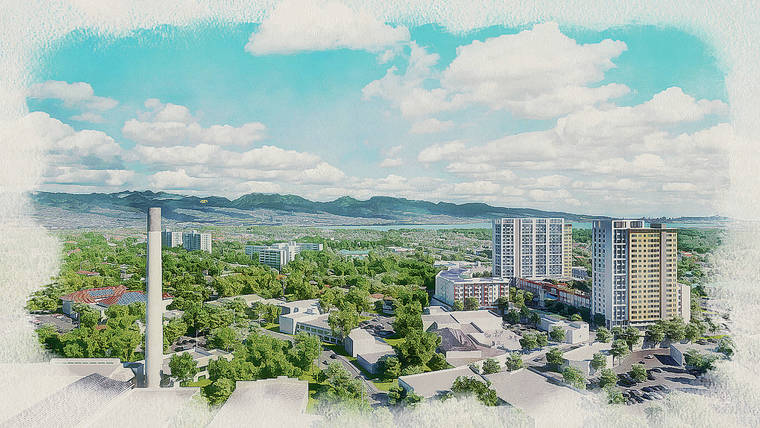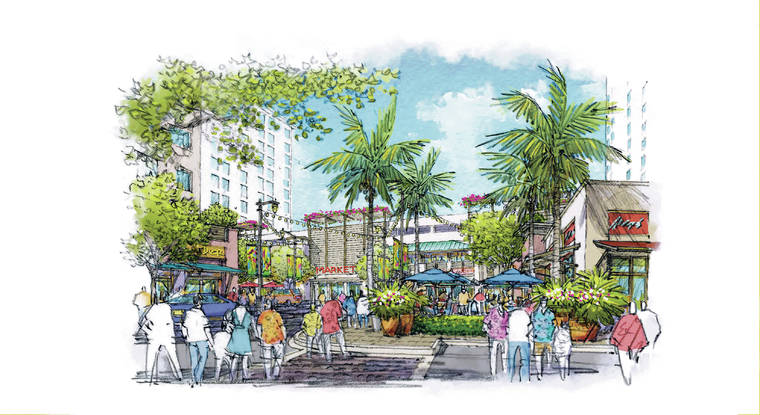A developer is seeking to build more than 500 low-income rental homes in Waipahu, though tentative
designs for two towers exceeding a city height limit by more than three times has triggered some community opposition.
The estimated $300 million project on Kamehameha Schools land almost adjacent to a city rail station and a bus transit hub is the latest in a growing number of affordable-housing projects in which developers contend they need major zoning exemptions to be financially feasible and address Hawaii’s long-running and worsening crisis of high housing costs.
The Waipahu project, led by Highridge Costa, a California-based affordable-housing development firm with experience in Hawaii, would produce about
530 homes with low rents if very high buildings — the tallest in Waipahu — are permitted by the City Council.
“This is really a very unique
opportunity to create affordable housing in an area that desperately needs it,” Mohannad Mohanna, head of development for Highridge, said in an interview.
Maximum monthly rents would range from $1,269 for studios to $1,885 for three-bedroom units if apartments were available today, and affordability linked to local household income would last 60 years.
Tenants could earn no more than 60% of the annual median household income for Honolulu, which currently equates to $50,760 for a single person, $58,020 for a couple and $72,480 for a family of four.
Tower heights, however, have drawn incredulity and criticism from a few members of the Waipahu Neighborhood Board briefed on the project during a meeting earlier this year.
Highridge seeks to develop a pair of 200-foot-high, or roughly 20-story, towers between Farrington Highway and Hikimoe Street that would contain about 400 apartments and exceed a 60-foot height limit.
A third building with 130 units reserved for seniors is slated for land on the mauka side of Hikimoe Street and would not exceed the height limit.
The proposed project, dubbed Keawalau at Waipahu, also would retain an American Savings Bank office building on the corner of Farrington Highway and Waipahu Depot Street and include about 50,000 square feet of new commercial space including a grocery store on the site that is currently anchored by Times Super Market.
All the commercial real estate would be owned by Kamehameha Schools, which would lease the residential portions of the land to Highridge.
Annette Yamaguchi, a neighborhood board member, said during an April meeting that the tower plan is out of character with Waipahu, where the tallest structure is a 175-foot former sugar mill smokestack regarded as an iconic feature of what used to be a center of Oahu’s sugar plantation industry.
“Twenty stories high?” she said of the tower
plan. “I have no comprehension how this will fit
in with the normal flow of our community.”
Richard Oshiro, another board member, told Mohanna and Duff Janus,
director of commercial property planning and development for Kamehameha Schools, that they need to start over with their plan. He also questioned whether they had read the city’s transit-oriented development guidelines for Waipahu adopted in 2014 after much community input.
“This is not the kind of project that we want to see,” Oshiro said, explaining that the towers would compete with the smokestack. “This is totally contrary to what the community had planned for in their TOD plan. … We didn’t want Kakaako on the West side.”
TOD plans for neighborhoods surrounding rail stations typically allow height and density bonuses for projects that provide community benefits such as affordable housing.
But Waipahu’s TOD plan, which was the first one adopted by the City Council, offers no such bonus because an overriding principle in the plan is to maintain the “Old Waipahu Town” character with smaller-scale development.
“This area is defined by its plantation town character with the Waipahu Sugar Mill smokestack acting as an icon for the neighborhood,” the plan states.
The smokestack was once part of Oahu Sugar Co., which was established in 1897, became the largest employer in Waipahu and shut down in 1995.
Two other members of Waipahu’s 19-member board, Connie Herolaga and Maureen Andrade, said they understood the need for affordable housing but couldn’t accept the proposed tower height.
“I don’t want — like Pearl City, you got twin towers over there sticking out like a sore thumb. That’s not what we want to see in Waipahu,” Herolaga said.
The board hasn’t taken a position on the project yet, though the developer has asked for its support and intends to return for a future meeting.
Kamehameha Schools and Highridge also shared their plan at a town-hall meeting in April and expect to hold a similar meeting in September.
Mohanna told the neighborhood board that the development team, which also includes the local nonprofit AHED Foundation, understands that the high-rise
element of the project is not an “easy ask” and that there is no intention to fight the community. However, Mohanna also is hopeful that the community’s desire for affordable workforce housing is stronger than opposition to building heights.
To illustrate demand
for affordable housing,
Mohanna noted that a Highridge project in Kapolei called Hale Moena Ohana attracted about 1,000 applicants for 143 low-income rental apartments completed earlier this year.
“I believe the demand will be significantly higher (in Waipahu),” he said. “We are making a very serious commitment to helping (address) the problem of affordable housing.”
Cory Chun, Waipahu Neighborhood Board chairman, said producing affordable housing in Waipahu has strong community support, though he would like to see the developer address tower height concerns.
To carry out the plan, Highridge intends to seek a height limit exemption under a state affordable-housing law known as 201-H, which can permit such exemptions for projects that produce homes mostly for households that earn no more than high-
moderate incomes.
A prior example of a 201-H project in Waipahu was Plantation Town Apartments, which was built in 2007 by a private developer on state land. This twin-tower project exceeded the 60-foot height limit by 45 feet and also raised community concerns about height.
Highridge also intends to seek state and federal tax credits to help finance the residential portion of its project. Such tax credits are available from the Hawaii Housing Finance and Development Corp., a state agency, for low-income housing projects.
Ultimate approval for the zoning exemption will be up to the City Council and would involve public hearings.
The developer expects that if approvals are obtained, construction could begin in mid-2023 or 2024 and be done in phases.






